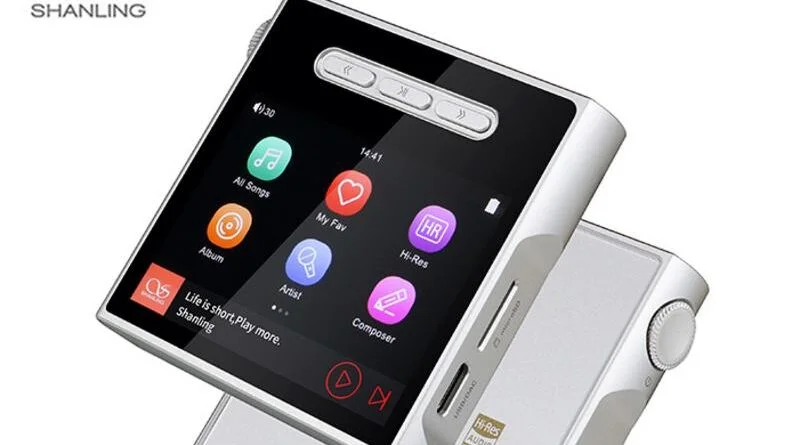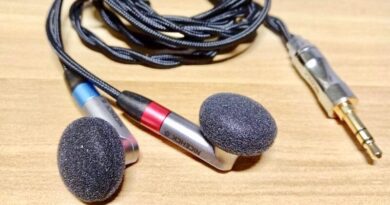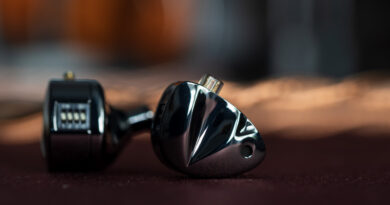Shanling M1s Portable Hifi Player Review – She Blinded Me With Science
As evidenced by the death of the iPod, separate DAPs seem ever-more inessential. Still, mobile phones have limitations as music players—they’re generally less portable, have limited storage and even with many amps may struggle to drive more challenging headphones. Plus, of course, true audiophiles will always opt for more devices, however superfluous or expensive.
The $217 Shanling M1s was proved by Aohsida Audio for my review – and I thank them for that. You can get it from Aoshida Audio.
Shanling’s new $217 M1s packs a lot of functionality and tech into its smallish (70mm x 70mm) package, including MQA/DSD decoding, Bluetooth receiving and transmission, gapless playback, Wifi connectivity, standalone DAC capability and 14h battery life. Beautifully machined metal casing is a bit heftier than anticipated, but conveys a sense of solidity, and the 2.8” screen has good visibility (I would pop the extra $10 for the optional leather case).
UI (which combines a physical volume wheel and responsive touch controls) is logical and well-conceived. Onboard EQ and digital filter options are catnip for technogeeks. The user manual is extremely minimalist and doesn’t provide guidance beyond basic operation of the controls—I was able to muddle through Bluetooth connection, file downloading etc., but Luddites beware.
Note further that the DAP utilizes Shanling’s simplistic OS, which has a built-in Tidal app but (at least for now) doesn’t allow other Android apps. In practical terms, this means if I want to listen to a Steve Bannon podcast on Spotify, I need to remain tethered to my mobile, which undermines the utility of having a separate DAP.
Shanling maintains that other apps aren’t viable because of the MS1’s screen size (and some maintain Android-based systems are sonically inferior), but a more inclusive OS would have been ideal.
I first tested the M1s as DAC/amp, playing Coltrane and Radiohead in lossless, Tidal MQA and 320kb OGG through my Kindle Fire and a Dell laptop (note that a driver is required for Windows). Because the MS1 uses the same ESS ES9038Q2M chips as Shanling’s UA5 and UA2 dongles (albeit with a more powerful amp), I expected the M1s to sound more-or-less the same—warmish, smooth and balanced across the different frequencies.
Instead, the M1s has quite a different signature—tonally a bit bright, with lean, crisp notes and a conspicuously forward midrange which highlights horns/male voices. Bass is tight and controlled but not especially deep or visceral; high end is very well-extended and presents a lot of microdetail.
Perhaps because of the midrange emphasis, I hear the soundstage as fairly narrow and low-ceilinged, although performers remain well-separated and imaging is accurate if somewhat two-dimensional.
The M1s immediately scores in two respects. First, it has a ton of driving power, especially through the 4.4mm output–it can drive the 300 ohm Senn HD600 effortlessly and really gets a grip on the wobbly bass of my 60 ohm Koss KSC74. It can, however, be a bit much for very sensitive IEMs, even in low gain setting—something like the KZ ZS10P or TRN-VX show more high-end glare and metallic timbre than with lower-powered sources.
OTOH, synergy with the more power-hungry Blon BL-03 was great, with the Blon sounding fuller-bodied and bassier than typical. The M1s are not without coloration—horns in particular sound amped-up and slightly billowy—but this an extremely revealing, live-sounding piece.
Second, and most pronouncedly, the M1s is as unforgiving and revealing of source as you’ll hear—poorly-recorded or low-rez files sound crappy, while well-recorded, hi-rez files are richly detailed and impeccably clear. Nothing is smoothed over; the sonic difference between say, a Tidal master-quality track and the same track on Spotify is massive.
Especially since I inevitably listen to a lot of sub-par recordings, this is a mixed-bag—the M1s can sound over-analytical without careful matching of file and headphone. Optimally paired, however—say a 24bit/192Hz take of “A Love Supreme” through the aforesaid HD-600—the M1s sounds very transparent and lifelike, with considerable energy and top-to-bottom coherence.
I did test the M1s as a Bluetooth streamer to my Sony WH-1000XM4 and it was fine—easy connectivity, good range—while the LDAC codec very clearly presents more sonic information than generic AAC. However, other than playing louder I can’t honestly state that even after tweaking the EQ on the MS1 to augment low end tracks on the M1s sounded much better or different than the same tracks played through my Pixel mobile.
Plainly, the highest and best use for the M1s is as a portable player through wired phones, where its power and transparency are on full display. I loaded a ton of FLAC and WMA (as well a couple of DSD tracks) onto a microSD card (not included; there is also no onboard storage, which is a curious omission). Again, my big takeaway was just how much better than Bluetooth this wired setup sounded—gutsier, punchier, with much more high-end definition.
Not having other DAPs on hand, I borrowed a ($200ish) Sony NW-A55 from a gym mate to compare. The Sony is a nice-sounding piece with more intuitive ergonomics and better battery, but trails the M1s sonically in most respects. Most notably, the Sony has much lower output power and isn’t suitable for higher impedance loads.
This is manifest mostly at the low end, which sounds softer and less impactful than the Shanling’s. The Sony has a warmer, smoother tonality which does work well for low-quality files but is significantly less resolving and extended at both ends. I also found the Sony’s various DSP tunings artificial-sounding.
The M1s isn’t perfectly neutral, and treble-averse folks might find it a bit spicy on top. As noted above, it is also brutally revealing of poor recordings. It is, however, unquestionably a lot of machine for the money and will make your higher-impedance wired headphones sound brawnier and better. Thumbs way up.
Disclaimer: sent to me gratis by Aoshida Audio https://aoshida-audio.com/ . Unless Jürgen has some covert arrangement with them [he has not], we get nothing (other than more gear) for touting their wares.
Specifications Shanling M1s
| Dimensions: 72 × 69 x16 mm Weight: 106g Screen: 2.8-inch 640*480 touchscreen DAC: ESS ES9038Q2M Digital filters: 7 Amplifier: 2x Ricore RT6863 Battery Life: 14.5 SE / 10.5 BAL / 26h Bluetooth Battery: 2100 mAh Memory: MicroSD card slot, up to 2TB Output: 3.5mm SE and 4.4mm BAL Bluetooth: 5.0 BT Transmitter: LDAC, apt HD, aptX, AAC, SBC BT Receiver: LDAC, AAC, SBC Wi-Fi Support: Airplay, DNA, OTA Updates Hi-Res support: Up to 32/768, DSD512 and MQA USB DAC: Up to 32/384 and DSD256 Music formats: DSD (” iso”,”.dsf”, “.dff”) *ISO DST not supported ISO / DXD / APE / FLAC / WAV / AIFF / AlF / DTS / MP3 / WMA / AAC / OGG / ALAC / MP2 / M4A / AC3 / M3U / M3U8 / OPUS 3.5mm Single-ended Output Output power: 144mW@32 h Frequency Response: 20Hz-40kHz (-0.5dB) THD+N: 0.0007%@320 (A-Weight@0.5V) Dynamic range: 123dB@32 h (A-Weight) Channel separation: 76dB@32 h Signal-to-noise ratio: 1220B@32 (A-Weight) Noise floor: 116dB (A-Weight) Output impedance: 0.40 ohm 4.4mm Balanced Output Output power: 245mW@32 g Frequency Response: 20Hz-40kHz (-0.5dB) THD+N: 0.0008%@320 (A-Weight@1V) Dynamic range: 123dB@32 Q (A-Weight) Channel separation: 108B@32 h Signal-to-noise ratio: 118dB@32 (A-Weight) Noise floor: 110dB (A-Weight) Output impedance: 0.80 ohm |









